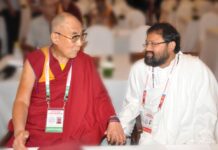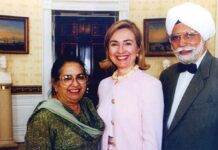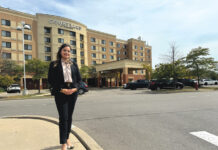By Khushwant Singh
It was one day in mid-June, 1947 in Lahore. Hot, still and silent. People were rudely shaken out of their siestas by shouts and exploding crackers. Since March, their nights had been disturbed by sporadic gunfire and mobs yelling in the streets, hurling slogans like missiles.
From one end Muslims armed with knives and lathis shouted Naara-e-Takbeer followed by full-throated Allah-O-Akbars. From the other end came the reply: Har Har Mahadev and Boley-se-Nihal-Sat Sri Akal.
Stones were thrown at each other, abuses exchanged, and unwary pedestrians stabbed to death. The police fired to disperse mobs, a few people were killed before peace was restored. Next morning, the papers reported the casualties like Muslims Vs the Rest cricket scores.
The score was invariably in favour of Muslims. The chief reason for Muslims having the upper hand was that the umpires were Muslims. Over 80 per cent of Punjab Police was Muslim; the state government was Muslim-dominated. It was the same story all over western Punjab. Hindus and Sikhs had begun pulling out of Muslim-dominated towns to Lahore. And finding Lahore equally unsafe, trudged on to Amritsar and towns of eastern Punjab where Hindus and Sikhs outnumbered Muslims.
That June afternoon of 1947 remains etched in my mind. I had returned from the Lahore high court when I heard the uproar. I ran up to the roof of my apartment. The sun burnt down fiercely over the city. From the centre billowed out a huge cloud of dense, black smoke. I did not have to make guesses; the Hindu-Sikh mohalla of Shahalmi was going up in flames. Muslim goondas had broken the back of non-Muslim resistance. After Shahalmi, the fight went out of the Hindus and Sikhs of Lahore. We remained mute spectators to Muslim League supporters marching in disciplined phalanxes chanting: Pakistan ka Naara Kya/ La-Ilaha-Il-Lal-lah.
The turmoil had little impact on the well-to-do who lived around Lawrence Gardens (today’s Bagh-e-Jinnah), and on either side of the canal which ran on the eastern end of Lahore. We went about in our cars to our offices, spent evenings playing tennis at the Cosmopolitan or the Gymkhana Club, had dinner parties where Scotch which cost Rs 11 per bottle flowed like waters of the Ravi. In elite residential areas, the old bonhomie of Hindu-Muslim bhai bhai-ism continued. We placed a lot of faith in the Unionist government of Khizr Hayat Tiwana who had Hindus and Sikhs in his cabinet and was strongly opposed to a separate Muslim state. League leaders turned their ire on him. Processionists chanted: Taazi Khabar, Mar Gaya Khizr. Then he threw in the sponge. Overnight he became the hero of Muslim sloganeers: Taazi Khabar Aayee Hai/Khizr Hamara Bhai Hai.
The juggernaut gathered speed. Hindus and Sikhs began to sell properties and slip out towards eastern Punjab. One day I found my neighbour on one side had painted in large Urdu calligraphy Parsee Ka Makaan. One on the other side had a huge cross painted in white. Unmarked Hindu-Sikh houses were thus marked out. We were within walking distance of Mozang, a centre of Muslim goondas. I did not see anyone being killed but, unknown to me, escaped being murdered myself. I had gone to do a case in Abbottabad. I decided to walk down to Taxila to catch a train to Lahore. I was surprised to see the road deserted. Suddenly a lorryload of Sikh soldiers pulled up and a lieutenant ordered me to get in. “Are you crazy?” he shouted. “They have killed all Sikhs in neighbouring villages and you are strolling.”
At Taxila station, I noticed the train halt at a signal. Sikhs were dragged out and killed. At Badami Bagh, there was another massacre. Locked in my first-class bogey, I neither saw nor heard anything. At Lahore, my friend Manzur Qadir (later foreign minister of Pakistan) was on the platform to take me home.
By July 1947, stories of violence against Muslims in east Punjab circulated in Lahore, and a trickle of Muslim refugees flew westwards. This further roused Muslim fury. The last time I went to the High Court I saw a dozen Sikh students of National College in handcuffs. They were charged with the murder of two Muslims on Grand Trunk Road, running in front of their college. Among them was Ganga Singh Dhilion, later pioneer of the demand for Khalistan. They were produced before Justice Teja Singh, the only Sikh judge. He released them on bail. That had become the pattern of justice.
A week before Independence, Chris Everett, head of the CID in Punjab who had studied Law with me in London, advised me to get out of Lahore. Escorted by six Baluch constables, my wife and I took a train to Kalka to join our two children who had been sent ahead to their grand-parents in Kasauli. By arrangement, I met Manzur Qadir coming down from Simla and handed him the keys of my house.
Then, I drove down to Delhi. There was not a soul on the 200-mile stretch. I arrived in Delhi on August 13, 1947. The next night I was among the crowd outside Parliament House chanting Bharat Mata Ki Jai. We heard Sucheta Kripalani’s voice over loudspeakers singing Vande Mataram. Then Nehru’s Tryst with Destiny speech. What a Tryst it was! And what Destiny! (This article appeared in Outlook on May 28, 1997)









s